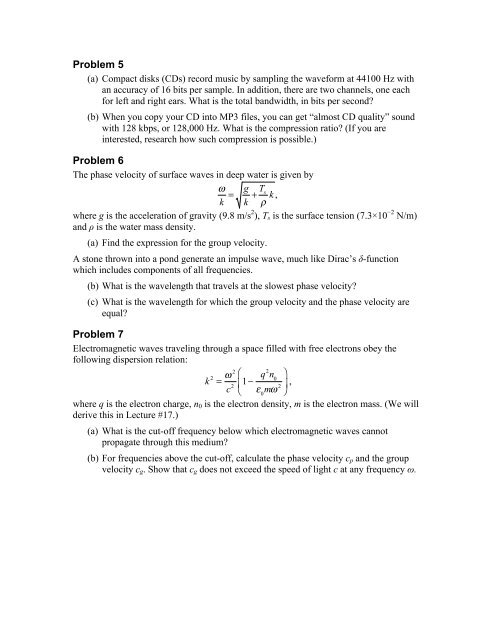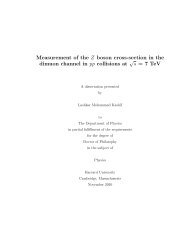Physics 15c Problem Set #5
Physics 15c Problem Set #5
Physics 15c Problem Set #5
You also want an ePaper? Increase the reach of your titles
YUMPU automatically turns print PDFs into web optimized ePapers that Google loves.
<strong>Problem</strong> 5<br />
(a) Compact disks (CDs) record music by sampling the waveform at 44100 Hz with<br />
an accuracy of 16 bits per sample. In addition, there are two channels, one each<br />
for left and right ears. What is the total bandwidth, in bits per second?<br />
(b) When you copy your CD into MP3 files, you can get “almost CD quality” sound<br />
with 128 kbps, or 128,000 Hz. What is the compression ratio? (If you are<br />
interested, research how such compression is possible.)<br />
<strong>Problem</strong> 6<br />
The phase velocity of surface waves in deep water is given by<br />
where g is the acceleration of gravity (9.8 m/s 2 ), T s is the surface tension (7.3×10 −2 N/m)<br />
and ρ is the water mass density.<br />
(a) Find the expression for the group velocity.<br />
A stone thrown into a pond generate an impulse wave, much like Dirac’s δ-function<br />
which includes components of all frequencies.<br />
(b) What is the wavelength that travels at the slowest phase velocity?<br />
(c) What is the wavelength for which the group velocity and the phase velocity are<br />
equal?<br />
<strong>Problem</strong> 7<br />
Electromagnetic waves traveling through a space filled with free electrons obey the<br />
following dispersion relation:<br />
k 2 = ω 2 ⎛<br />
1− q2 n 0<br />
⎞<br />
c 2 ⎜<br />
⎝ ε 0<br />
mω 2 ⎟<br />
⎠<br />
,<br />
where q is the electron charge, n 0 is the electron density, m is the electron mass. (We will<br />
derive this in Lecture #17.)<br />
(a) What is the cut-off frequency below which electromagnetic waves cannot<br />
propagate through this medium?<br />
(b) For frequencies above the cut-off, calculate the phase velocity c p and the group<br />
velocity c g . Show that c g does not exceed the speed of light c at any frequency ω.















